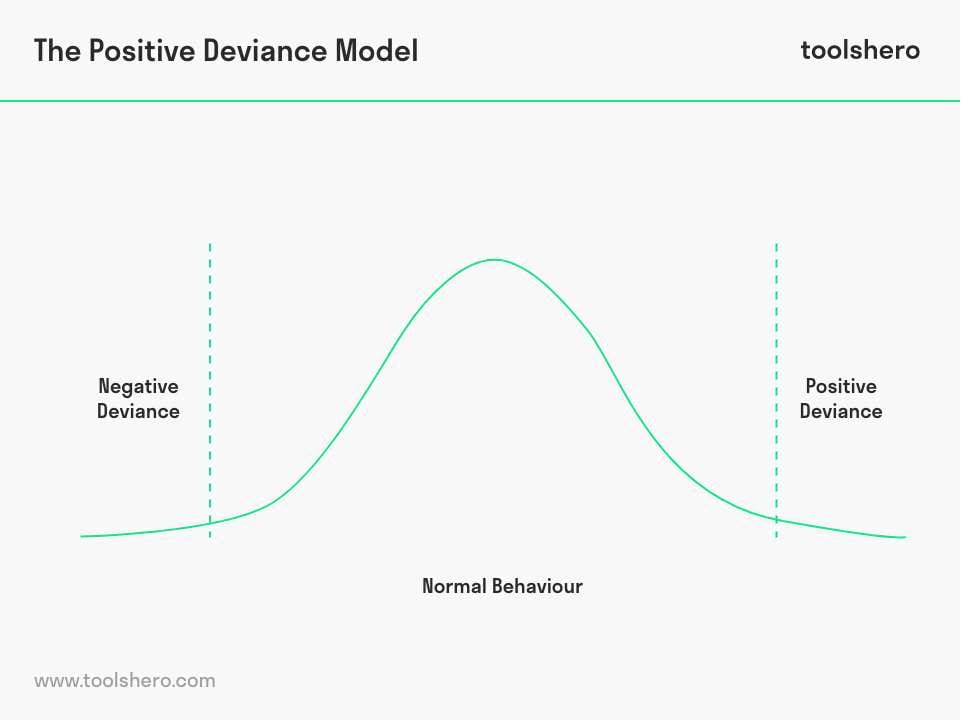Positive Deviance (PD) explained

Positive Deviance: this article explains positive deviance in a practical way. The article starts with the definition of positive deviance, followed by an explanation about the concept and some practical examples. You will also read about the positive deviance model and the steps involved in this process. Enjoy reading!
Definition of positive deviance
Positive deviance (PD) is a behavioral and social change approach that dictates that in every community, individuals face the same challenges, limitations, and flaws, but that some come up with better solutions and successful behaviors to their problems than others.
These individuals are called positive deviants. Positive deviance is the opposite of negative deviance. The term is often used to describe deviant behavior, both positive and negative.
What is positive deviance?
The concept of Positive Deviance (PD) originated in the 1970s, when it started in nutritional research and case study. Researchers found that, despite the severe poverty in a community, some families had better-fed children than others.
Some researchers then suggested using knowledge from these parents to plan feeding programs and save the children.
The PD approach has since been widely used by researchers for development purposes.
The strengths-based approach is based on five principles:
- Community members have the solutions and expertise to best address their own problems;
- Communities are self-organizing entities with sufficient human resources and other resources to find solutions to shared problems;
- community members possess a collective intelligence, that is, evenly distributed across the community, which elicits a PD approach;
- The foundation of any PD approach rests on sustainability and the actions needed to enable a community to discover and solve their own problems;
- Behavioral change is best achieved through practice and learning by doing.

Figure 1 – The Positive Deviance Model
What is negative deviance?
According to conflict theory, deviant behavior is the result of social, material or political inequality in a social group. The labelling theory states that people start to exhibit deviant behavior as a result of the fact that people are given a certain identity and adopt this identity.
Negative deviance refers to behavior that does not meet the set and accepted norms in a social group. People who exhibit negative deviance either reject a society’s norms, misinterpret the norms, or are completely oblivious to the norms. Examples of this are stealing, skipping school, picking your nose or other unacceptable behavior.
Steps in the Positive Deviance process
PD is also seen as a positive mindset, more than a model or theory. It also doesn’t literally dictate what people should do, but rather acts as a guide. The strengths of this mindset are its simplicity, applicability and brevity.
The mindset is ideal for tackling a persistent problem that requires a solution that includes social change for individuals or groups.
Four D’s are important in this process: Define, Determine, Discover and Design. These steps are explained below and are derived from the positive deviance study by Pascale.
Step 1: Define
The problem is defined or noticed first within a community. Members of this community are forced to learn to deal with this problem, as in the case of hunger. Outsiders have no influence on this and it is wise not to define and refine this problem themselves.
To help, they must contact the community to gain insights that clearly explain the problem. A picture needs to be made of what an improved or ideal situation would look like in the future. After that, problems and barriers related to the problem are examined. An important part of this is identifying the stakeholders.
Step 2: Determine
The community is most qualified to identify everyday practices and behaviors. Outsiders seeking to help may, in coordination with the community, organize meetings to involve them in identifying activities, lessons and priorities with the aim of solving a problem.
Step 3: Discover
The third step, or third phase, is all about discovering the positive deviants. These are the positive deviant behaviors within a community that produce positive outcomes.
Actions at this stage include:
- Identifying the individuals in a community who face the same challenges, but who achieve positive outcomes with the same resources
- Interviewing the people who exhibit deviant behavior
- Identifying unusual practices and behaviors that lead to better outcomes
- Sharing the learned lessons with the rest of the community
Step 4: Design
The fourth phase is an extension of the third phase, and revolves around designing an initiative that extends the reach of the solution.
The following actions are part of this:
- Applying the learned positive behavior on a larger scale
- Rolling out the solution to an ever-increasing extent
- Connecting people who weren’t connected before
- Creating opportunities to learn
- Monitoring the overall effectiveness of the initiative
If all phases have been successfully completed, it is important that the insights gained and proposed behaviors are documented. These can then be shared outside the original community with individuals and communities facing similar issues.
Examples of positive deviance
There are many examples of positive deviance in communities where successful results have been achieved.
Type 2 diabetes
In Epsom, UK, a public health initiative collaborated with patients who were successful in managing type 2 diabetes (T2D).
The positive deviance initiative project was led by Dr. Zanetti and is an example of a PD approach. Researchers identified patients who had found creative means to manage their medication and diet and developed a healthy coping mechanism with the support of their partners.
After that, so-called intervention evenings were organized, namely the Diabetes Dinner Club & Discussion. Here the positive deviants passed on their knowledge to the individuals who were less able to cope with their illness.
Other examples
Other examples of PD:
- Malnourished children in Vietnam
- Hospital infections
- Cystic fibrosis
- Hypertension
- Cancer care
The benefits of such a problem-solving approach are not just limited to healthcare initiatives. The method has also proven effective in the sustainable development of energy supplies, in criminology, psychology, computer technology and management & leadership.
Positive deviance summary
Positive Deviance (PD) is a problem-solving method aimed at making changes based on positive exceptions within a community. The method is based on the fact that some people within a particular community achieve better results than others who face the same challenges and problems. The higher goal is innovators solve the world.
By applying the method behind the PD approach, many people have been helped in the past, such as children in famine. The method has also been developed in this context; in the 1970s, researchers found that some people in a hungry community fed their children better than others. These people are called positive deviants, or positive exceptions.
The first stage of the this approach involves defining the problem. This is done within the community itself, not by outsiders. The next step is to identify everyday practices and behaviors within this community. The third step is about identifying the positive deviants. The fourth phase revolves around designing an initiative that is scalable and can be shared with others within the same community and beyond.
The method has proved successful with a large number of inactive people, including managing type 2 diabetes (T2D) and cancer care, as well as in non-medical settings such as sustainable energy supply, criminology and psychology.
Now It’s Your Turn
What do you think? Do you recognize the explanation about positive deviance? Do you know an example of a situation in which you learned from others to learn how to deal with problems? Do you think a PD approach can be applied to tackle major problems in the world? Do you have any tips or comments?
Share your experience and knowledge in the comments box below.
More information
- Bradley, E. H., Curry, L. A., Ramanadhan, S., Rowe, L., Nembhard, I. M., & Krumholz, H. M. (2009). Research in action: using positive deviance to improve quality of health care. Implementation science, 4(1), 1-11.
- Lapping, K., Marsh, D. R., Rosenbaum, J., Swedberg, E., Sternin, J., Sternin, M., & Schroeder, D. G. (2002). The positive deviance approach: Challenges and opportunities for the future. Food and Nutrition Bulletin, 23(4_suppl_1), 128-135.
- Marsh, D. R., Schroeder, D. G., Dearden, K. A., Sternin, J., & Sternin, M. (2004). The power of positive deviance. Bmj, 329(7475), 1177-1179.
- Spreitzer, G. M., & Sonenshein, S. (2004). Toward the construct definition of positive deviance. American behavioral scientist, 47(6), 828-847.
How to cite this article:
Janse, B. (2022). Positive Deviance (PD). Retrieved [insert date] from Toolshero: https://www.toolshero.com/problem-solving/positive-deviance/
Original publication date: 03/31/2022 | Last update: 09/27/2023
Add a link to this page on your website:
<a href=”https://www.toolshero.com/problem-solving/positive-deviance/”>Toolshero: Positive Deviance (PD)</a>












